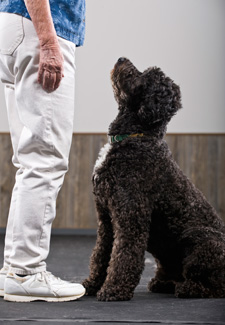Your Dog Is Never Too Old for Training
Published on September 19, 2012

Set Reasonable Expectations for Your Older Dog
Although senior pets are able to learn and perform new behaviors, there are a few factors to be aware of. Many older dogs have difficulty with behaviors that require extensive stamina or strength, making tasks like competitive flyball or agility training unrealistic. Senior pets also have possible changes in the brain associated with aging that can affect learning. One potential way to combat brain aging is to ask your veterinarian about adding fatty acids and brain health supplements to your dog's diet, such as Neutricks, which may help with healthy brain aging. Finally, if your pet develops behavior changes in old age, don’t jump right to training, but consult with your veterinarian first, as some changes can be linked to medical issues that your veterinarian needs to address, such as canine cognitive dysfunction syndrome.
As long as your dog is physically and mentally capable of performing the behavior and has the proper motivation, the benefits of training are endless and will provide you and your dog with a method of bonding and communicating that cannot be achieved otherwise.
How Training Benefits You and Your Dog
Recently, Moxie, a newly adopted 10-year-old Boston Terrier, came into my training class. She had no prior training and growly manners with other dogs. Moxie’s pet parent, Cheryl, was a first-time small dog owner and she wanted to start their relationship off right. Moxie quickly learned the basics, such as sit, down, stand and heel, and very soon began to outperform her younger peers with tricks, such as shake and spin. Despite all of the other dogs in class being years younger than Moxie, she rose to class stardom and unabashedly became the teacher’s pet, stepping up as my demo dog for most of the exercises we learned.
By the end of class, Moxie not only had a foundation in training that would make most pet owners envious, but she had even changed her growly reactions toward other dogs and was able to stay relaxed when she was approached. Even better than Moxie and Cheryl's training progress, though, was the strong bond they naturally acquired as they learned to communicate through the training in a language they both could understand.
This communication is key. When I begin reward-based training with a senior dog, I am often convinced that I can hear an audible sigh of relief from the dog when he realizes that he finally has a way to talk to his people.
I adopted a senior Pomeranian named Teddy from a small dog rescue when he was well into his old age. Teddy had suffered years of neglect. When we started training, Teddy was inhibited and cautious. One of the first ways I interacted with him was by teaching him some basic behaviors, such as sit and down. After only a few repetitions of clicking wanted behavior, I could almost see a spark in his eyes as he began to enthusiastically try out new behaviors to see if they were clickable. Despite his age, Teddy gained confidence and learned new behaviors at a fast pace once he understood what I was asking him to do. He had figured out how to communicate with me, and it completely changed his attitude.
Whether your dog is 10 months old or 10 years old, it's never too late to start training.





